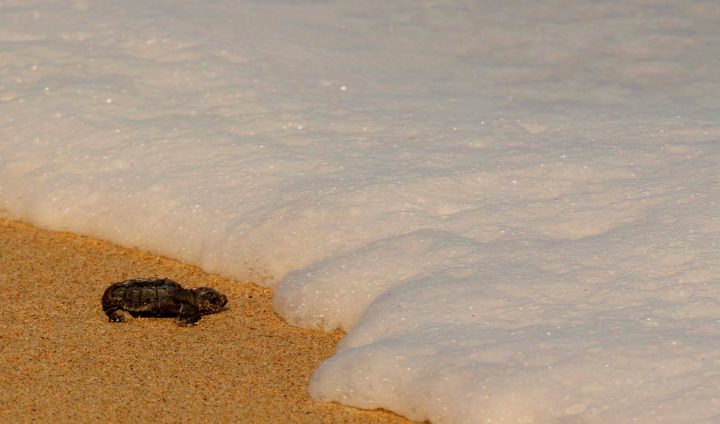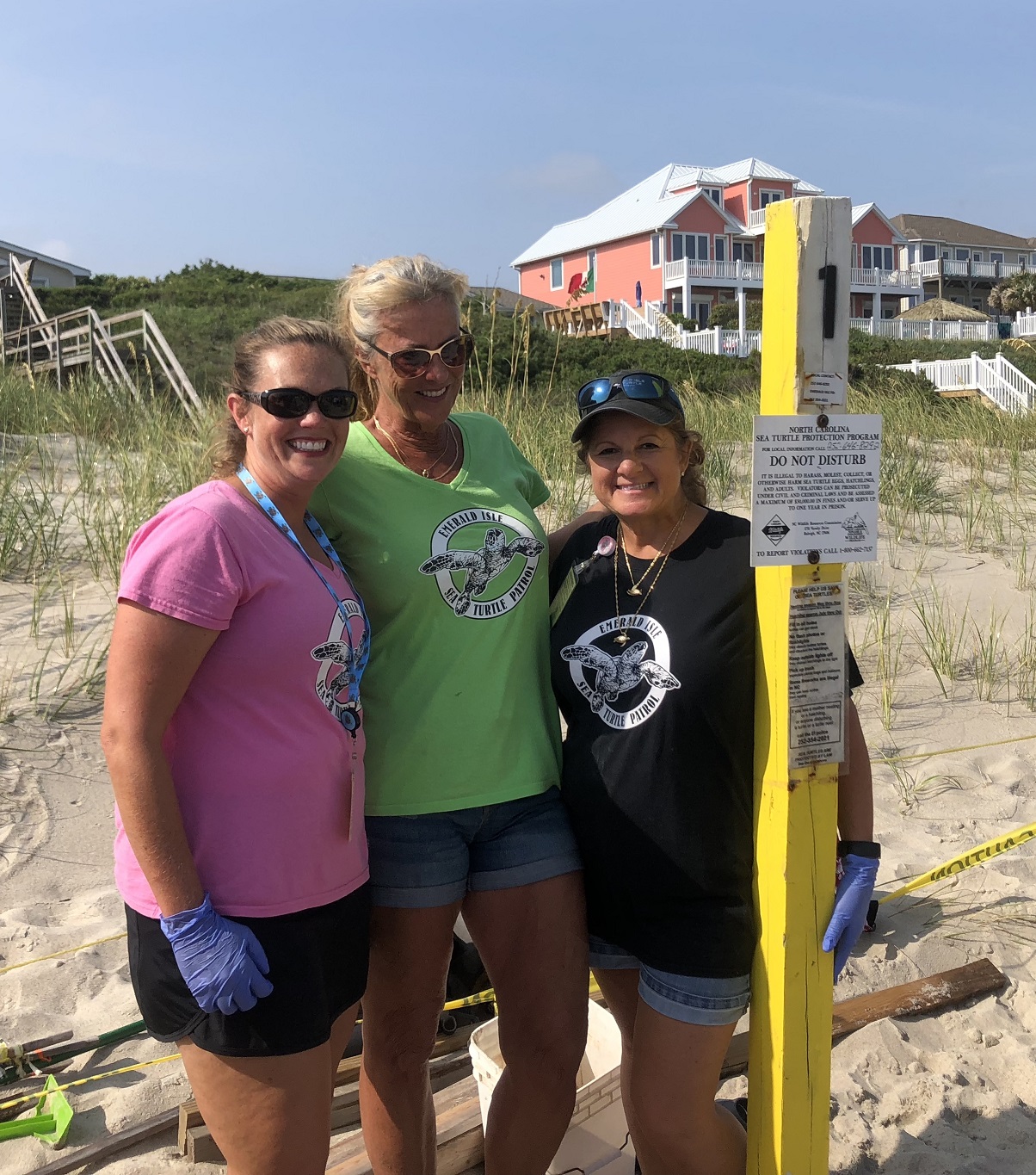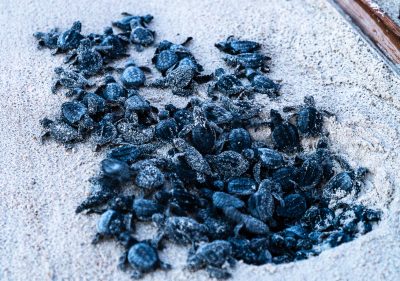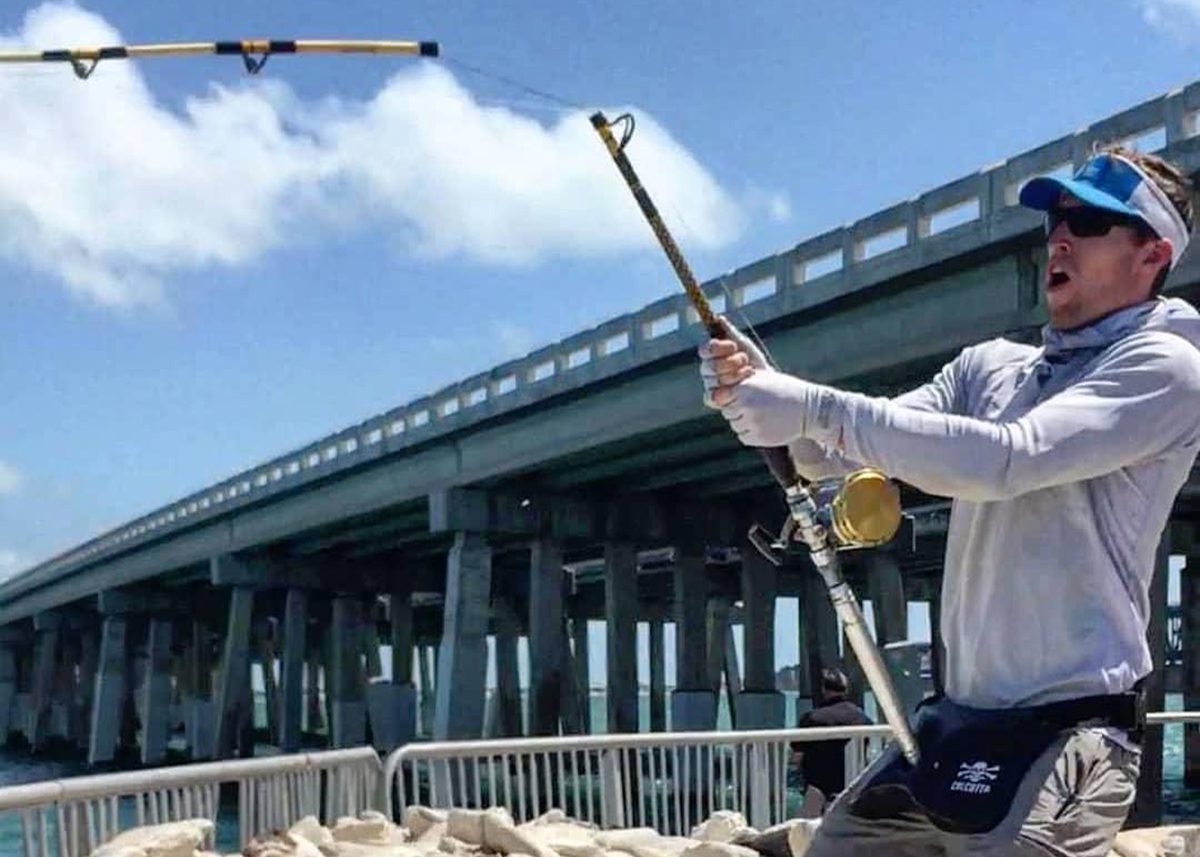
EMERALD ISLE – They came and set up their beach chairs in the darkness and waited while the lullaby of crashing waves attempted to sooth them asleep. Yet, they were too excited for sleep and would not surrender to that dark silent curtain.
For 11 nights, volunteers endured rain, tortuous mosquitoes, howling wind and on one night it was so cool that they wrapped up in blankets sipping on hot tea. They told stories to pass the time and on clear nights, they gazed deep into the stars and into the misty Milky Way. On one of these nights, they were able to see the International Space Station as it arched across the sky. As it streaked by at 17,500 miles per hour, one of the observers, commented, “It is kind of a juxtaposition staring up at modern technology while waiting on something from prehistoric years.”
Supporter Spotlight
Sea turtles are thought to have been swimming the oceans of the Earth since the late Jurassic period, around 150 million years ago.
After walking day after day, scouring the beach for sea turtle tracks carved in the sand, citizen-science volunteers hope to find a nest full of eggs. Almost two months of patience is then required for the warm summer sun to incubate the eggs deep in their sandy den. After 50 days of incubation, the volunteer nest-sitters will start their nightly vigil. They now wait for their reward, to see baby hatchlings make their trek to the ocean.

On May 20, around 4:30 p.m., one of these primeval beasts swam ashore and crawled up the sloping beach to the base of the primary dune in Emerald Isle. However, this particular turtle was different from the typical loggerhead sea turtles that we have come to expect along the North Carolina coast. Much to the surprise of a few beachcombers, this female nested during the daytime, which would be unusual for a loggerhead or green sea turtle. In addition, the tracks etched in the sand were quite narrow for these large reptiles. These clues led to the conclusion that this nesting female was a Kemp’s ridley sea turtle, a critically endangered species.
The rarest and the smallest of all seven species of sea turtles, the Kemp’s ridley weighs in at around 100 pounds with an oval-shaped, olive-grey-colored shell reaching 2 feet in length. This is less than half the size of a loggerhead. What makes this nest even more interesting is that Kemp’s are mostly found in the shallow waters of the Gulf of Mexico, where they munch on crabs, shrimp and shellfish. Some of these sea turtles make their way around the Florida Keys and head up the Atlantic Coast all the way to Nova Scotia. Some have even crossed the pond and have been found off the coast of Ireland. These wandering turtles are usually juveniles that have taken a ride on powerful ocean currents.
The Kemp’s ridley has been a bit of a mystery, a riddle, if you will. Noticed by early sailors and fishermen, it was long thought to be a hybrid sea turtle unable to produce eggs, since no one had ever documented a nesting female.
Supporter Spotlight
This small sea turtle caught the eye of a fisherman from Key West, Florida, Richard Kemp. He recognized distinctions that led him to believe that this was a unique species and sent a specimen to Harvard University. In 1906, his study and identification of this reptile led scientists to name the turtle in his honor.
Knowledge about the Kemp’s ridley nesting biology remained a conundrum for scientists for another 56 years. Since biologists have never seen them nest, it was theorized that the female might produce live hatchlings. It was also thought that the Kemp’s species had somehow become infertile and that the species would eventually die out.
In 1947, Andres Herrera, identified as an engineer, sportsman, naturalist and a tourist in various writings, was flying his small plane along the coast between United States and Mexico. Looking down on a beach near the Mexican town of Rancho Nuevo, Herrera witnessed not hundreds, but thousands of Kemp’s ridley sea turtles on the beach and those in the water he described as “blotches of confetti.”
Herrera had heard rumors and whispers of a nesting spectacle such as this and came prepared with a 16 mm camera. He landed his plane on a nearby beach and began filming this daytime mass nesting known as an “arribada,” or mass arrival. At last, the riddle was solved! All the biologists now knew where the Kemp’s ridley nests.
Well, hold on, not just yet.
Satisfied with his find, Herrera put aside the film, perhaps in a drawer where it sat for 13 years. Somehow, in 1960, the film came to be viewed by the eccentric Henry Hildebrand, a marine biologist. Hildebrand shared the film with the scientific community much to the delight of famed sea turtle researcher Archie Carr.
Carr, who, for years, had walked hundreds of miles of ocean shoreline in search of nesting Kemp’s, was so excited that he proclaimed,“It made Andrés Herrera in my mind suddenly a cinematographer far finer than Fellini, Alfred Hithcock, or Walt Disney could ever aspire to be. … to me Andrés Herrera is a man who ought to be knighted, or to get a Nobel Prize, or some kind of prize.”

A study of Herrera’s film determined that close to 40,000 Kemp’s nested on that day alone along a stretch of beach 16 miles long. With the cat now out of the bag, researchers descended on Rancho Nuevo. But upon arrival, they were surprised to find only around 2,000 nesting individuals.
Since the time of the Herrera discovery, the harvesting of the eggs and the turtles themselves had severely decimated the population. Thought to be a powerful aphrodisiac, the eggs were like gold, fetching a high price. With each turtle laying around 100 eggs, this was a lucrative business.
With this being the only significant nesting site for the Kemp’s ridley, the Mexican government took action to protect this nesting site. However, the numbers continued to fall due to poaching and their accidental capture in fishing trawl nets. The species was on the road to extinction.
In the late 1970s, the United States and Mexican governments collaborated with biologists through the Kemp’s Ridley Sea Turtle Restoration and Enhancement Project to establish a new nesting colony at Padre Island National Seashore in Texas. This bold experiment would test the theory that sea turtle hatchlings somehow imprint on the beach where they hatched.
Newly laid eggs on the beaches of Mexico were transported to Padre Island. Here they were incubated and as the hatchlings scampered down the beach, they would hopefully, pick up on natures cues that this is “their” beach. Recent research indicates that they somehow utilize the earth’s geomagnetic field to find their way home. Thousands of eggs were relocated for years and in 1996 the first nesting adult female returned. In 2017, 353 Kemp’s nested on Padre Island National Seashore. After 40 years, this project is continuing to foster the recovery of this species.
As some of the Emerald Isle nest-sitters were distracted by the bioluminescent algae glowing in the surf, at 1:30 a.m. one of the volunteers noticed a depression in the sand above the nest chamber. After 60 days, the eager hatchlings were climbing on the backs of each other like rungs on a ladder. Finally, just before dawn, the tiny creatures seemed to boil from the sand. Cautious at first, they began to crawl toward the ocean with the escort and protection of their volunteer guardians. As the incoming waves reached out to greet them, they scrambled down the beach where their beaks were finally kissed by the sea.
Their journey had just begun.

A few days after the nest hatched, Dale Baquer, Emerald Isle Sea Turtle Patrol program coordinator, supervised an excavation of the nest to inventory the contents. Zone coordinators Jami Thomas and Sue Toth began the delicate task of digging through the sand to locate the empty eggshells and rescue any stragglers still in the nest. After a little digging, the white leather-like shells spilled from each handful of sand. The shells were organized in neat rows to ensure an accurate count.
Quite a crowd had now gathered, curious to see what was going on. A murmur of excitement jolted the group like an electrical current as two tiny hatchlings were found deep beneath the empty shells. Families with children were lucky to be strolling down the beach at just the right time. Like security guards protecting a celebrity, the sea turtle volunteers kept the giddy crowd at a distance as these two strutted to the ocean on a carpet of sand. This nest was a great success, out of 86 eggs, 82 developed into strong hatchlings that made it into the ocean.
As I watched the hatchlings, I realized that of the hundreds of nests that I excavated and inventoried during my career as a park ranger, I had never seen a Kemp’s ridley hatchling. I watched them closely, urged toward the ocean by an instinctual zest for survival and on a collision course with the baptism of a white, foamy wave that would sweep them into their ocean home.








